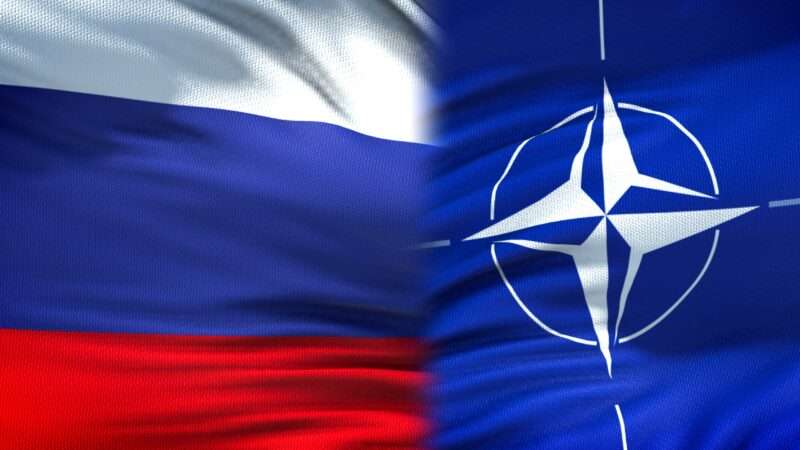
After a meeting of defense ministers last month, NATO leaders will convene again next week in the Lithuanian capital of Vilnius. There they're expected to approve a significant update to the alliance's military posture on its eastern flank, where several members––Finland, Estonia, and Latvia––share a border with Russia, and several more––Poland, Slovakia, Hungary, and Romania––border Ukraine.
Right now, NATO has about "40,000 troops on standby from Estonia in the north down to Romania on the Black Sea," reports the Associated Press. With the new plan, the alliance "aims to have up to 300,000 troops ready to move to its eastern flank within 30 days."
The motivation is obvious: Russia invaded Ukraine last year, and last month's failed Wagner rebellion highlighted a dangerous vulnerability in Moscow, a nuclear power. NATO's easternmost members are eager for military reinforcement, with Lithuania long requesting a permanent foreign military presence in its territory (preferably American, though German may have to suffice).
"Russia is the most significant and direct threat to allies' security, and we must be prepared for it to remain so," said a June statement from the Bucharest Nine, a group of eastern NATO members, which urged defensive military buildup to "deny any opportunity for [Russian] aggression."
What should be equally obvious, however, is the very real risk of this plan given its likely reception in Moscow. NATO members' goal is to deter Russia, but the unfortunate reality is that one man's defense is another man's offense. What the allies see as commonsense protection, Russian President Vladimir Putin will—justifiably or not—interpret as saber rattling. With the best of intentions, NATO could end up with less security and more security dilemma.
Putin's probable read on NATO's new strategy is most intelligible if you know a bit about NATO history. From Moscow's perspective, the alliance has repeatedly broken its word regarding eastern expansion in the post–Cold War era while dismissing Russian worries about Western military strategies, including troops moving ever closer to Russian land.
After the fall of the Soviet Union, "we were assured that NATO did not plan to move eastward," Russian Ambassador to the United States Anatoly Antonov wrote in Foreign Policy in 2021. "When such a movement inevitably started in 1999, our counterparts claimed that these assurances were just nice friendly conversations between then–U.S. Secretary of State James Baker and [then–leader of the Soviet Union] Mikhail Gorbachev without any assumed legal obligations," he continued, referring to a 1990 meeting in which Baker said three times that NATO would expand "not one inch eastward."
Since then, NATO has had six waves of expansion, counting Finland's accession this year, all moving the edge of the alliance farther east. And, as Antonov recounted it, whenever Moscow "express[es] concern, we are told, in effect: 'Just trust us.'"
Now, maybe that's exactly what Russia should do. Maybe Putin's government should believe the U.S. and our allies when we say that this expansion is strictly defensive in nature and that we do not seek regime change in Moscow.
But—without granting a whit of moral legitimacy to Russia's invasion of Ukraine, which is cruelly unjust in its initiation and execution alike—we should also be able to see why such trust would be difficult for Russian leadership. The fact is NATO has expanded east after high-ranking alliance members' officials promised it wouldn't, and the United States has been doing a lot of regime change in the last 22 years, including with NATO support.
Putin was certainly wrong to attack Ukraine and claim that NATO made him do it. He might well be wrong to think NATO is threatening him at all. But it's not a wildly irrational conclusion in this historical context.
That's why there's a risk of stumbling unintentionally into a security dilemma here. A security dilemma, as Harvard's Stephen M. Walt explained in Foreign Policy, "is a tightening spiral of hostility that leaves neither side better off than before." It starts when "the actions that one state takes to make itself more secure—building armaments, putting military forces on alert, forming new alliances—tend to make other states less secure and lead them to respond in kind."
Crucially, the actions of the first party (in this case, NATO) needn't be actually meant as a threat for the other party (Russia, and perhaps allies like Belarus) to feel less secure and respond with hostility. The perception of threat is enough—and, especially fresh off the Wagner crisis, it's not hard to imagine a weakened Putin perceiving threats everywhere. A new NATO posture of 300,000 troops ready to fight at a month's notice will be impossible for him to ignore.
The post When More Troops Mean Less Security appeared first on Reason.com.







